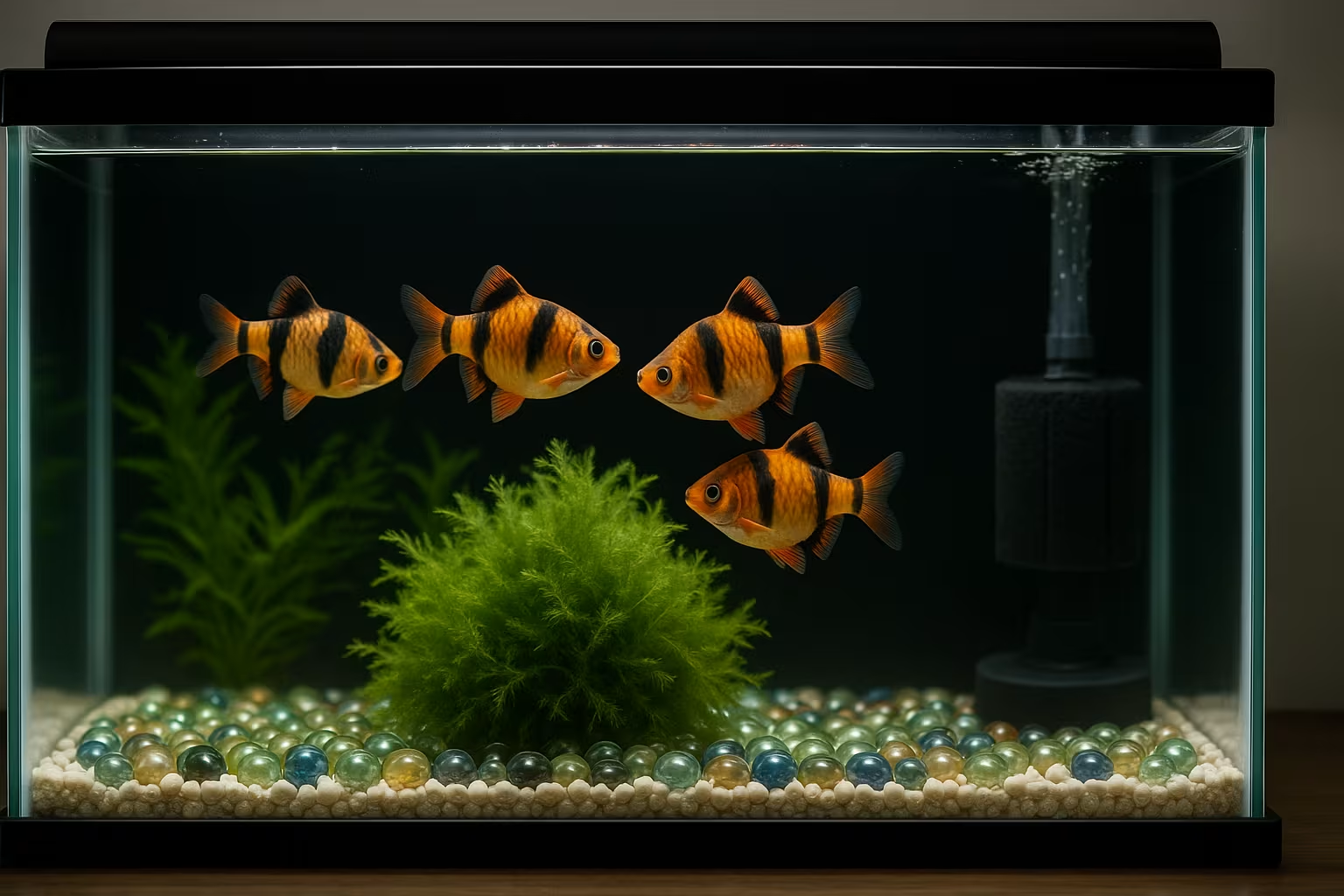

Home-bred Golden Tiger Barbs adapt faster to local water, cut wild-collection pressure, and give you a fresh generation that already knows flake food. The process is straightforward if you plan ahead and resist rushing the eggs into the main tank.
| Step | What to do | How long | Why it works |
|---|---|---|---|
| Separate sexes | Males and females in their own 10-gallon tanks | 7 days | Stops casual spawning, lets ovaries fill with eggs |
| Feed high-protein diet | Frozen brine shrimp mornings, quality pellets evenings | 10 days | Boosts egg count and sperm quality |
| Warm them up | Raise temp from 76 °F to 78 °F | Last 3 days | Mimics pre-monsoon warmth that triggers breeding in the wild |
Sexing tip: Males stay slimmer and show deeper orange; females look rounder when viewed from above.
| Item | Minimum spec | Placement note |
|---|---|---|
| Tank | 10 – 15 gal bare bottom | Near a quiet wall—sudden shadows make barbs scatter |
| Spawning grate or marbles | ½-inch layer | Eggs fall out of reach so parents can’t eat them |
| A small sponge filter | Gentle flow | Keeps water clear without sucking up fry |
| Clump of Java moss or spawning mop | Center | Gives fish a “target” to scatter eggs |
Fill with aged water, same chemistry as the conditioning tanks, and set temp to 80 °F—a two-degree bump often sparks courtship within hours.
Evening before lights-out: Move one plump female and two active males into the spawning tank.
Next morning: Gradually raise the light level; bright light plus fresh food kick-starts chasing.
Watch for eggs: Tiny clear spheres drop through the grate or settle in moss. Spawning usually finishes before noon.
Remove adults as soon as the chase stops barbs turn egg-hungry the moment they calm down.
| Stage | Day | What happens | Your task |
|---|---|---|---|
| Eggs | 0–1 | Turn opaque if infertile | Siphon white eggs to stop fungus |
| Hatch | 2–3 | Fry hang like commas on glass | Keep light low; no food yet |
| Free-swim | 4–5 | Fry start darting | First foods: infusoria or commercial liquid fry food |
| Growth spurt | 7+ | Able to eat newly hatched brine shrimp | Feed 4 small meals per day; 20 % water change daily |
Maintain temp at 80 °F until day 10, then drop a degree every other day until it matches the main tank’s 76 – 78 °F.
| Problem | Cause | Solution |
|---|---|---|
| Fungus spreading on eggs | Low water flow or too many infertile eggs | Add airstone near eggs and remove dead eggs promptly |
| Fry vanish after free-swim | Parents left in too long or tankmates added | Keep spawning tank adult-free for at least 4 weeks |
| Slow growth, bent spines | Irregular feeding or dirty water | Stick to four feeds daily and daily small water changes |
Use a flashlight at night to count fry—tracking numbers early helps you catch losses before they snowball.
Wait until fry reach ½ inch and show faint stripes (roughly week 5).
Match temperature and pH between tanks within 0.2 units and 1 °F.
Net gently plastic tumblers work better than mesh nets for tiny fish.
Introduce juveniles into a grow-out tank first; mixed ages in a community tank leads to bullying and stunted runts.
Breeding Golden Tiger Barbs is less about fancy gear and more about timing: condition well, give eggs a predator-proof drop zone, and feed microscopic foods on schedule. Follow the timetable and you’ll raise a healthy, stripe-bright generation ready for your display or for responsible sharing with fellow hobbyists.
Next up, Article 8 covers beginner-proof automation timers, auto-feeders, and Bluetooth monitors that keep your aquarium stable while you’re away.
Restock alerts, care tips, and the occasional coupon one email a month, unsubscribe anytime.